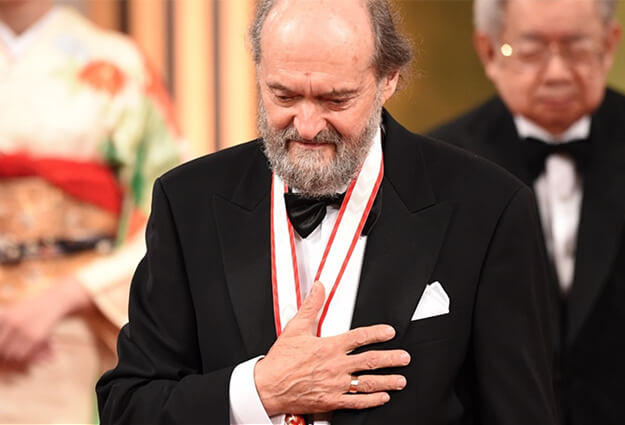 Arvo Pärt accepts the prestigious Praemium Imperiale cultural award in Tokyo presented by the Japan Art Association. Photo: news.err.ee
Arvo Pärt accepts the prestigious Praemium Imperiale cultural award in Tokyo presented by the Japan Art Association. Photo: news.err.ee
1. The continuing global success of Arvo Pärt’s music
At the beginning of the year, Estonian composer Arvo Pärt was, for the third year running, given the title of the “world’s most performed living composer” by the classical music event database, bach-track.com. Placing 38th in the overall composers’ ranking, he was ranked higher than his two principal competitors, Scottish composer James Macmillan, who came 45th, and veteran film music composer John Williams, who was ranked in 77th place.
Few weeks later came an announcement that Estonian conductor Tõnu Kaljuste had won a Grammy Award in the Best Choral Performance category for his work on Pärt’s album “Adam’s Lament” at the 56th Annual Grammy Awards in Los Angeles. “Adam’s Lament” was recorded with Pärt’s active participation in the resonant 13th-century church of St. Nicholas in Tallinn, that surrounds the singing with a hazy echo.
In late May and early June, The Estonian Philharmonic Chamber Choir and the Tallinn Chamber Orchestra with conductor Tõnu Kaljuste performed the music of Arvo Pärt at four sold-out concerts in the United States – two in Washington, DC, and two in New York City, including one at the world-renowned Carnegie Hall. Pärt also attended the concerts.
In October, The Japan Art Association presented Pärt with the prestigious Praemium Imperiale cultural award. The award is considered equal to the Nobel Prize in the field of culture, and was presented to Maestro by the patron of the association, Prince Hitachi of Japan.
2. The emerging success of Estonian film industry
In September, Estonian film director and producer Ilmar Raag’s movie “Kertu” was selected as one of the 50 best films this year, recommended for a nomination for the European Film Awards, the so-called European Oscars.
In November, “Pilots on the way Home”, an animation by a veteran animator Priit Pärn, took home a grand prix prize from the Fredrikstad Animation Festival 2014, held in Norway.
In December, the Estonian-Georgian movie, “Tangerines” (“Mandariinid” in Estonian), was nominated for the Golden Globe award in best foreign film category. Already one of the most, if not the most, successful film involving Estonian filmmakers, notching up tens of international awards since 2013, it has also made among the nine films that have advanced to the next round of voting in the Foreign Language Film category for the 87th Academy Awards.
Estonian movie industry managed to release four full-length movies in 2014: “Kirsitubakas” (“Cherry Tobacco”) by Katrin and Andres Maimik, “Ma ei tule tagasi” (“I Won’t Come Back”) by Ilmar Raag, “Maastik mitme kuuga” (“Landscape with Many Moons”) by Jaan Toomik, and “Nullpunkt” (Zero Point) by Mihkel Ulk.
The Black Nights Film Festival – PÖFF, as it is known in Estonia – received recognition from the International Federation of Film Producers Associations (FIAPF), making it among the 15 most important film festivals in the world, and now able to hand out world-wide awards.
3. The most popular Song Celebration yet
The 26th Estonian Song and 19th Dance Celebration drew the highest ever number of participants and audience from 4-6 July – over 153,000 people visited the performances.
33,025 singers and 10,082 dancers took part of the festival; the joint choir for the grand finale consisted of just over 22,000 singers.
“I’m extremely happy to be born in Estonia, to be speaking Estonian language. I’m grateful to be able to give my little contribution to ‘laulupidu’, there is nothing better that that,” the artistic director of the festival, Hirvo Surva, said.
4. The emerging success of Estonian design
For the third year in a row, the Estonian fashion industry was represented at the International London Fashion Week, as part of the International Fashion Showcase – a collaborative project launched by the British Council and the British Fashion Council in 2012. For the second year in a row, it also won the International Fashion Showcase award.
In spring, the Estonian design review exhibition “Size doesn’t matter”, representing nearly 60 designers, travelled around Europe, showcasing emerging and already established talents.
In April, the Estonian-invented Stigo foldable scooter won an “Electricity and Smart Living” award from the French electricity producer EDF.
The garden house called Noa, designed by an Estonian architect-inventor Jaanus Orgusaar, was one of the highlights at the UK top home show, Grand Designs Live, held at the London ExCel Centre in May.
Estonian-designed Viks bicycle was selected among the “TOP 10 bike designs of 2014” by designboom.com.
5. Tallinn Music Week growing in impact
Tallinn Music Week (TMW) took place for the sixth time this year, from 27-29 March, attracting notable names in the music industry and 227 bands from 20 countries to the Estonian capital. The three-day music industry conference and one of the biggest indoor festivals in the Nordic and Baltic region brought members of the notorious Russian punk protest group, Pussy Riot, to Tallinn; as well as Robert Levine, the former executive editor of the Billboard magazine; Kerli, the most successful Estonian pop artist of all time, and others.
In November, British quality daily The Guardian placed the Tallinn Music Week among the Top 10 music festivals for winter breaks.
Helen Sildna, the founder of the festival, was awarded the Exceptional Achievements in Music Business award at the Tampere Music Awards 2014.
news.err.ee















